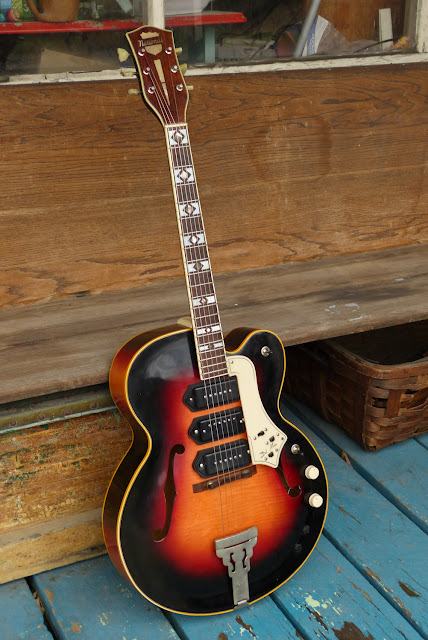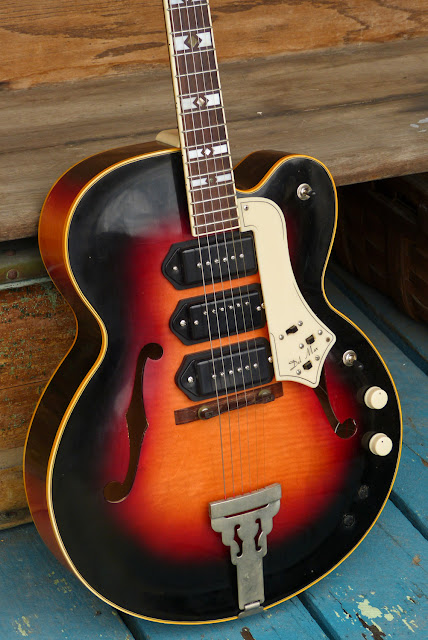1955 National 1103 Del Mar Hollowbody Jumbo Electric Guitar
Update: I've updated the photos and the description as I changed the electronics a bit.
Honestly, I'm just about as bad as the lot of you reading the blog! The solder was barely cool on my freshly-bought, freshly-modded 1950 National Aristocrat (also Gibson-bodied -- see here for a more in-depth post on it) when an even fancier variant popped-up on Reverb at a price I could justify. Knowing how things disappear -- especially when you like them -- I had to spring for it... and here she be. While the Aristocrat uses a non-cutaway, ES-300 Gibson body with a National "Stylist" neck, this model -- the Del Mar -- uses an ES-350, soft cutaway body with the same 17" width.
Honestly, I'm just about as bad as the lot of you reading the blog! The solder was barely cool on my freshly-bought, freshly-modded 1950 National Aristocrat (also Gibson-bodied -- see here for a more in-depth post on it) when an even fancier variant popped-up on Reverb at a price I could justify. Knowing how things disappear -- especially when you like them -- I had to spring for it... and here she be. While the Aristocrat uses a non-cutaway, ES-300 Gibson body with a National "Stylist" neck, this model -- the Del Mar -- uses an ES-350, soft cutaway body with the same 17" width.
There's scant evidence that the Del Mar model even existed. A writeup about the more-known National Bel Aire model (with its ES-175 body) gives a rare description:
"In 1954, National introduced the 1109 Bel Aire, an ES-175 body with two Valco pickups, block inlays, a symmetrical headstock, and other mid-level appointments; it sold for $225. The same year also saw the introduction of the 1103 Del Mar, an ES-350 body with two pickups, a bound, rosewood-veneered headstock and “butterfly” inlays that sold for $350 (in the same range as a L-7CESN). For whatever reason, National changed their minds by 1956 when both models were dropped from the catalog."
So, like the Aristocrat, it was placed at the top of National's hollowbody electric line.
This one had been modified sometime in the 60s to use a set of three "gold foil" pickups, but its original equipment would've been two metal-cased National single coils with the look of humbuckers but a sound more like mellower P90s. The pickguard was also recut a little when that mod was done to fit the third pickup in the middle. I'm not sure how the controls were laid-out originally, but I'm sure the switches on the pickguard are not original.
I'm a fan of gold foil pickups -- but not so much on something that's essentially a rockabilly or jazz guitar -- so after receiving this I yanked the pickups that were on it and replaced them with a pair of Alnico P90s and an Alnico mini-humbucker in a P90 cover. This gives the guitar an "ES-5" or "modded ES-350" look, which is easier on my eyes and more expected by my ears. After swapping those in and replacing the wiring harness (what was on it was funky as heck), my only other work was to give it a fret level/dress, a set of Thomastik flatwound strings, and a setup. Because it has a "Stylist" neck, the neck angle is adjustable via a bolt, so setup is a breeze on a guitar like this as there's adjustability at the heel and the bridge. The neck, due to its hunk-of-metal-wrapped-in-wood construction, is straight.
To me, this thing is the epitome of 50s wild, outsized, and wonderful -- though mixed with a bit of throwback deco motifs in the pearl on the fretboard. As you can hear in the clip above, too, it sounds great as well. The Gibson-made bodies on these are well-made, all ply, and durable as heck. Unlike the Aristocrat, this body also has the typical flamed maple veneer (on the front) seen on most Gibsons.
When I rewired this guitar, I made the controls extra-simple -- two 3-way switches and master volume and tone controls. I used 500k pots to keep the pickups sparkly and full-sounding and a .027 cap on the tone pot. The 3-way switches work as follows -- the top shifts between neck/bottom switch and the bottom switches between middle/bridge. This allows for every variation of switching with the three pickups and also lets me leave it in "normal two P90 Gibson" mode for the most part by leaving the bottom selector on the bridge P90.
I also filled two extra control holes, a little roughly, on the lower bout and simply removed the switches on the pickguard from the circuit. The original wiring seemed to have those switches do nothing and there was a pound's worth of wiring mess that seemed to involve individual volume for each pickup, a 3-on/neck only selector switch, and master volume and tone (though the master tone was a blend pot that seemed to only work as a second volume knob). The good news is that the tone and volume knobs on the guitar right now are the original Nat'l equipment and the rest is gone.
I also filled two extra control holes, a little roughly, on the lower bout and simply removed the switches on the pickguard from the circuit. The original wiring seemed to have those switches do nothing and there was a pound's worth of wiring mess that seemed to involve individual volume for each pickup, a 3-on/neck only selector switch, and master volume and tone (though the master tone was a blend pot that seemed to only work as a second volume knob). The good news is that the tone and volume knobs on the guitar right now are the original Nat'l equipment and the rest is gone.
One nice bit about the National-made necks is that they retained the 24 3/4" Gibson scale length and generally have a Gibson-esque feel, too, on the nicer-grade models. This one has a medium, round C neck shape and a fast, 1 5/8" nut width.
The rosewood-veneered headstock proudly displays the National brand in a proud pile of pearl.
The "butterfly" pearl inlay is fancy and the neck binding is thick stuff.
One nice bit about the National-made necks is that they retained the 24 3/4" Gibson scale length and generally have a Gibson-esque feel, too, on the nicer-grade models. This one has a medium, round C neck shape and a fast, 1 5/8" nut width.
One nice bit about the National-made necks is that they retained the 24 3/4" Gibson scale length and generally have a Gibson-esque feel, too, on the nicer-grade models. This one has a medium, round C neck shape and a fast, 1 5/8" nut width.
All of the pickups have "riser rings" of various sorts to get the pickups closer to the strings.
While I have P90 pickups in the neck and bridge positions for a more vintage-appropriate tone, I have a mini-humbucker in the middle position and it's hiding in a P90 cover. I mostly added this for effect as adding it to either the neck or bridge pickup mellows-up the tone and also removes a bit of volume as it has less output than the P90s on their own.
One nice switching option yields neck/mid or neck/mid+bridge from the top 3-way and that gives you a "neck lead" voice with more volume and a "backing/chords" voice with less volume.
One nice switching option yields neck/mid or neck/mid+bridge from the top 3-way and that gives you a "neck lead" voice with more volume and a "backing/chords" voice with less volume.
The f-hole tailpiece is, of course, too cool.
Here's the P90 in the bridge location and also the cool, deco-style National adjustable bridge. I always liked the sharp "lightning-bolt" intonation slots on these.
"Waffleback" Klusons with fancy buttons give it an upscale look.
That's a very decisive belt buckle!

























Comments